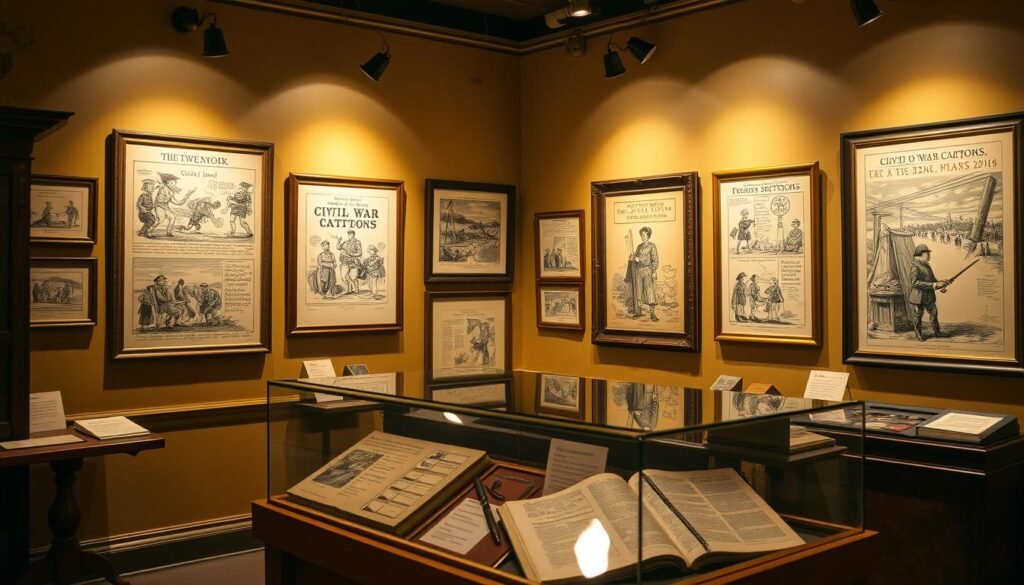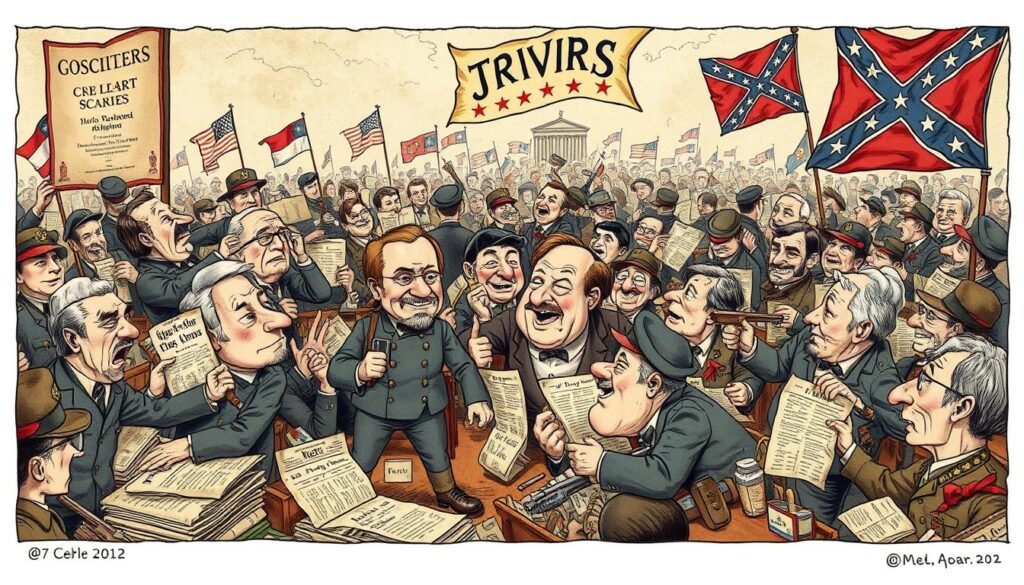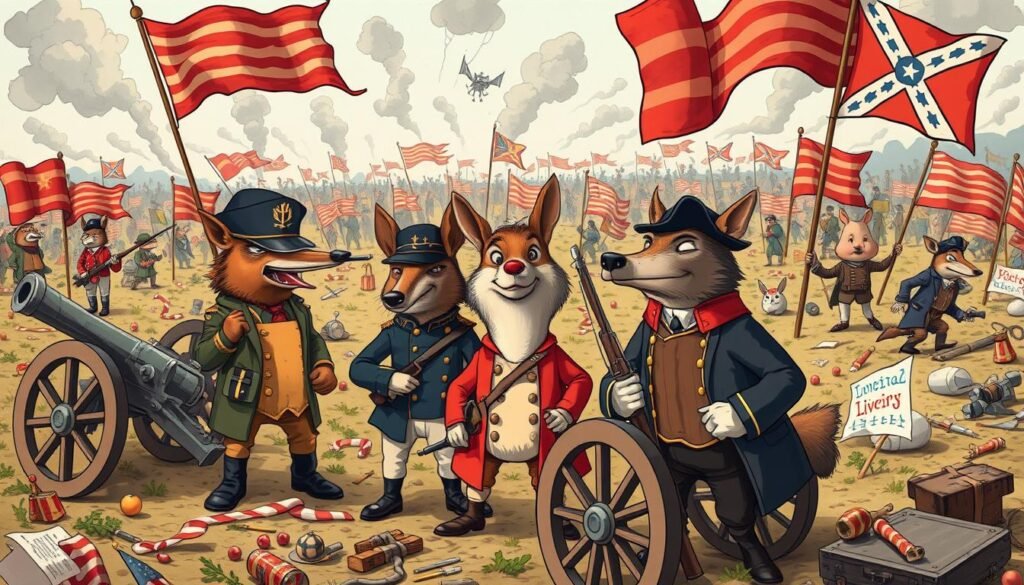Civil War Cartoons in Museum Exhibits and Archives
Over 40 important Civil War era cartoons are found in museums and archives. They show the politics and society of that time. These cartoons give a special look at the war and its effects on America.
Civil War Cartoons in Museum Exhibits and Archives cover a wide range of political views. They include cartoons about freedom, with both black and white figures pushing for it. Research shows these collections are key to understanding the war’s cartoons.
Key Takeaways
- Civil War cartoons were mostly produced between 1861 and 1865, featuring notable events such as the Battle of Bull Run.
- Historical cartoon collections provide a unique visual perspective on the war and its impact on American society.
- Over 40 significant Civil War era cartoons are located in various museum exhibits and archives.
- The presence of abolitionist themes is signified by cartoons showing both African American and white figures pushing for freedom.
- Civil War Cartoons in Museum Exhibits and Archives offer a broad spectrum of political commentary and public sentiment throughout the war.
- These historical cartoon collections are essential in understanding the context and significance of political cartoons during the Civil War.
- Civil War cartoons are a vital part of American history, providing insight into the sociopolitical climate of the time.
The Historical Significance of Civil War Era Political Cartoons
During the American Civil War, political cartoons from the Civil War era were key in shaping public opinion. Cartoonists used American Civil War satire to share their views. They often used propaganda to influence people’s opinions.
Artists like Adelbert Volck and Thomas Nast were major players. Volck made pro-Confederate cartoons that spread in the South. Nast’s Unionist cartoons were big in the North.
Role in Shaping Public Opinion
These cartoons were vital in shaping opinions, mainly in the North. They helped promote the Union and criticize the Confederacy. American Civil War satire made complex messages easy for many to understand.
Major Political Artists and Their Influence
Thomas Nast and Adelbert Volck were big influencers. Their political cartoons from the Civil War era helped sway opinions and support their causes.
Propaganda Techniques in Civil War Illustrations
Propaganda, like exaggeration and caricature, was common in Civil War art. These methods made messages strong and memorable.
The importance of Civil War era political cartoons is huge. They offer a special look into the politics of that time. They show how satire and propaganda can shape public views.
| Cartoonist | Notable Works | Influence |
|---|---|---|
| Thomas Nast | Uncle Sam’s Thanksgiving Dinner | Highly influential in shaping public opinion |
| Adelbert Volck | Pro-Confederate cartoons | Widely circulated in the South |
Notable Civil War Cartoons in Museum Exhibits and Archives
The National Archives in Washington, D.C., has a vast collection of Civil War cartoons. These include works by Adelbert Volck and Thomas Nast. These caricatures in museum displays offer a unique look into the politics and society of that time. Visitors can see these cartoons up close and learn about their importance.
Some notable examples of Civil War cartoons include:
- Works by Adelbert Volck, a prominent cartoonist of the time
- Cartoons by Thomas Nast, known for his influential illustrations
- Archival cartoon exhibits that showcase the art and history of the period
These archival cartoon exhibits give a fascinating look at how cartoons shaped public opinion during the Civil War. By looking at these cartoons, visitors can understand the historical context better. They also see how art was used to influence political discussions.
Types of Satirical Artwork from the Civil War Period
The Civil War era saw many satirical artworks, like cartoons and caricatures. These works in historical archives give us a peek into the politics and society of that time. They often mocked the opposing side, showing the Confederacy as cruel and the Union as tyrannical.
Caricatures were also used to comment on social issues. They tackled topics like slavery, racism, and women’s rights. Through these illustrations, we gain insight into the Civil War’s complexities and how humor shaped public views.
Union Perspective Cartoons
Cartoons from the Union side mocked the Confederacy and its leaders. These were shared in newspapers and magazines, reaching many people. They were a key part of the satire in historical archives.
Confederate Editorial Illustrations
But Confederate illustrations had a different view. They criticized the Union and its leaders. Published in Southern media, they offer a unique look at the Civil War and its humor.
Leading Museums Featuring Civil War Political Art
The United States has many top museums with Civil War era cartoons and illustrations. These museums let visitors see and learn about these historical pieces.
Places like the Billy Ireland Cartoon Library & Museum, the National Archives, and the Library of Congress are notable. The Billy Ireland Cartoon Library & Museum, for instance, has over 450,000 pieces of original cartoon art. This includes historical cartoon collections from the Civil War era.
These museums give a full view of the time. They show museum exhibits by famous cartoonists like Thomas Nast. Visitors can see how cartoons shaped public opinion and were used as propaganda during the Civil War.
By going to these museums, people can understand the Civil War political art better. They also help researchers and scholars study and analyze the historical cartoon collections and museum exhibits. This helps us know more about that time.
| Museum | Location | Notable Collections |
|---|---|---|
| Billy Ireland Cartoon Library & Museum | Ohio | Historical cartoon collections, original cartoon art |
| National Archives | Washington D.C. | Civil War era documents, historical records |
| Library of Congress | Washington D.C. | Historical cartoon collections, rare books, manuscripts |
Preservation Techniques for Historical Cartoons
Keeping historical cartoons safe needs special care. They are fragile and need careful handling and storage. Techniques like acid-free storage and climate control help keep them in good shape.
Some important ways to preserve them include:
- Environmental control: keeping the temperature and humidity steady to avoid damage
- Acid-free storage: using materials without acid to slow down decay
- Digital preservation: making digital copies of the cartoons
Fixing damaged cartoons is a big job. It takes a lot of skill and the right tools.
Many places are working hard to save these cartoons. The Library of Congress, for example, has a big collection. They also teach how to keep them safe. This way, we can make sure these cartoons are around for others to see in the future.
| Preservation Technique | Description |
|---|---|
| Environmental Control | Maintaining a stable temperature and humidity level |
| Acid-Free Storage | Using materials that are free from acid |
| Digital Preservation | Scanning and digitizing the cartoons |
Interpreting Civil War Cartoon Symbolism
Understanding the historical context and cultural references of the time is key to grasping Civil War cartoon symbolism. American Civil War satire used metaphors and motifs to share complex ideas and feelings. Animals or mythical creatures were often used in political cartoons from the Civil War era to stand for different political views or groups.
Common Metaphors and Motifs
These metaphors and motifs aimed to criticize or support various war aspects, like slavery, states’ rights, and economic policies. By studying these symbols, historians and scholars can dive deeper into the political and social climate of that era. For example, seeing Abraham Lincoln as a unifying figure or Jefferson Davis as a symbol of secession offers insight into how people viewed these leaders.
Political Figures in Caricature
Political figures, such as Abraham Lincoln and Jefferson Davis, were often shown in caricature, showing their strengths and weaknesses. These caricatures aimed to shape public opinion and sway political discussions. By looking at these caricatures, we can understand the impact of political cartoons from the Civil War era on the nation’s identity and how they informed citizens about current issues.
Digital Archives and Online Collections
The Library of Congress and the National Archives have worked hard to digitize their collections. Now, these digital archives are online for everyone. They offer a great chance for researchers and scholars to study historical documents and artifacts from anywhere.
The Library of Congress has a big collection online. It includes books, manuscripts, and photos about American history. The National Archives also has its collections online. You can find documents about the Civil War and other big historical events there.
These online collections are great for both researchers and the public. They let people learn from history and understand the past. You can see how events and people shaped America.
- Increased accessibility: online collections can be accessed from anywhere in the world, at any time.
- Improved preservation: digital archives help to preserve historical documents and artifacts for future generations.
- Enhanced research: online collections provide a wealth of information for researchers and scholars, allowing them to conduct in-depth studies and analyses.
| Collection | Description |
|---|---|
| Library of Congress Digital Collections | A wide range of materials related to American history, including books, manuscripts, and photographs. |
| National Archives Online Collections | Documents related to the Civil War and other significant historical events. |
Educational Value of Civil War Political Cartoons
Civil War political cartoons offer a unique peek into history. They are part of historical cartoon collections that teach history in a fun way. These cartoons grab students’ attention and make learning exciting.
Using cartoons and illustrations to teach history is very effective. It helps students think critically and analyze information. By studying these cartoons, students can improve their analytical skills.
Some great resources for teaching with Civil War political cartoons include:
- The Library of Congress, which offers extensive resources and a Political Cartoon Analysis Sheet
- HarpWeek, which maintains a historical database of Civil War and Reconstruction era cartoons
- The National Archive, which provides a Cartoon Analysis Worksheet to aid students in interpreting cartoons
By adding Civil War political cartoons to the curriculum, teachers can make learning more engaging. These historical cartoon collections show the educational value of these cartoons.
| Resource | Description |
|---|---|
| Library of Congress | Offers extensive resources and a Political Cartoon Analysis Sheet |
| HarpWeek | Maintains a historical database of Civil War and Reconstruction era cartoons |
| National Archive | Provides a Cartoon Analysis Worksheet to aid students in interpreting cartoons |
Impact on Modern Political Cartooning
The American Civil War satire and political cartoons from that time have shaped American political art. Today, many cartoonists find inspiration in these works. They use satire and propaganda in their own art.
Cartoons from the 20th and 21st centuries often reference the Civil War. They comment on today’s issues by comparing them to historical ones. This shows how cartoons can connect past and present.
The Civil War era’s influence can be seen in how cartoons depict politics today. By studying these cartoons, artists learn about the power of images in shaping opinions. They see how visual media can influence political talks.
Modern political cartooning owes a lot to the Civil War era. Key aspects include:
- The use of satire to critique political figures and events
- The incorporation of propaganda techniques to sway public opinion
- The depiction of historical events and figures in a modern context
These elements are core to modern political cartooning. They help artists comment on today’s issues in a way that’s both informative and fun.
| Technique | Description |
|---|---|
| Satire | The use of irony, sarcasm, and ridicule to critique political figures and events |
| Propaganda | The use of biased or misleading information to sway public opinion |
| Historical reference | The depiction of historical events and figures in a modern context |
Conclusion: Preserving Visual Legacy of the Civil War Era
Keeping the visual legacy of the Civil War era alive is key to understanding its history and culture. By protecting and sharing the cartoons and illustrations from that time, we can truly appreciate the art and history that defined America. Places like the Billy Ireland Cartoon Library & Museum, the National Archives, and the Library of Congress are at the forefront of this effort.
These groups use careful preservation methods to keep the powerful images and commentary from the Civil War era alive. They help educate, inspire, and engage people today. As we look back on this important part of our history, we must make sure to keep the visual legacy that offers a unique look into the past.
FAQ
What is the historical significance of Civil War era political cartoons?
Where can visitors view notable Civil War cartoons and illustrations?
What types of satirical artwork were created during the Civil War period?
How are historical cartoons preserved and made accessible to the public?
How can interpreting Civil War cartoon symbolism provide insights into the historical context?
What is the educational value of incorporating Civil War political cartoons into the curriculum?
How have Civil War era political cartoons influenced modern political cartooning?
Source Links
- Civil War Political Cartoons | Library Company of Philadelphia Digital Collections
- National Archives Presents Free Civil War-Themed Public Programs in January
- Microsoft Word – 177_Idris Young
- How Abraham Lincoln Was Portrayed in Political Cartoons | HISTORY
- The Legacy and Impact of Political Cartoons on National Identity
- The Art of Suffrage: Cartoons Reflect America’s Struggle for Equal Voting Rights | Constitutional Accountability Center
- Political Cartoons, Part 2: 1800-1850 – First Amendment Museum
- Ray, S. J. Papers | Harry S. Truman
- Pritzker Military Museum & Library Archival Collections | Pritzker Military Museum & Library
- The Comic News, Lincoln, and the Civil War
- Anderson Gallery welcomes Civil War cartoon exhbit
- Michael and Susan Kahn Political Cartoon Collection
- Thomas Nast (1840-1902) – Macculloch Hall Historical Museum
- Billy Ireland Cartoon Library and Museum |
- Preserving and Conserving Archived Photographs: An Annotated Bibliography
- Visual Materials: Processing & Cataloging Bibliography
- The Election of 1860: An Analysis of Editorial Cartoons
- Interpreting a Political Cartoon from the Eve of WWII
- Online Exhibits
- Research Guides: Civil Rights in America: A Resource Guide: Digital Collections
- Teaching Reconstruction using Political Cartoons: Civil War to Civil Rights Part 2
- political cartoons | Teachinghistory.org
- Presidential Campaign of 1948: Using Political Cartoons
- History in Ink: Preserving the World’s Largest Cartoon and Comic Collection | The Saturday Evening Post
- It’s A Good Act But It’s Hard On The Spectators
- The American Home Front and World War II (U.S. National Park Service)
- All Exhibitions – Exhibitions (Library of Congress)
























